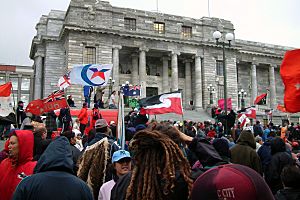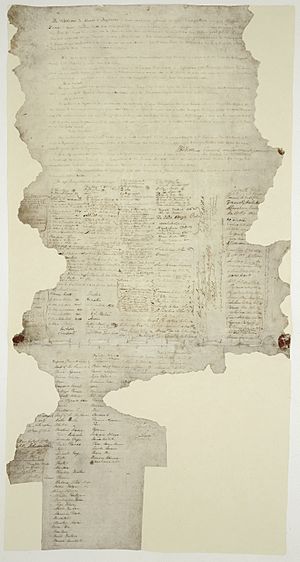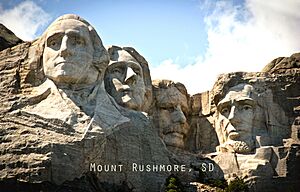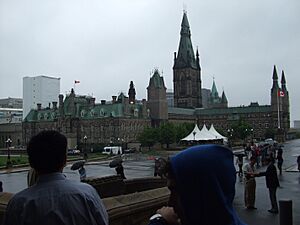Aboriginal title facts for kids

Aboriginal title is a special legal idea that says native peoples' land rights continue even after another country takes control of their land. It means that the original owners of the land still have rights to it, based on their old customs and traditions.
This idea is also called indigenous title or native title (like in Australia). It's a big part of understanding indigenous rights around the world. While judges first came up with this idea, many countries have now put it into their laws, treaties, or even their constitutions.
Aboriginal title was first recognized in the early 1800s. But it wasn't until recently that native peoples started winning big court cases to protect these rights. Most of these cases have happened in Australia, Canada, Malaysia, New Zealand, and the United States.
Contents
How Aboriginal Title Started

Aboriginal title grew out of old British laws. When the British Crown (the government) took over new lands, they usually respected private property rights that were already there. This meant that if people already owned land, the new government was supposed to recognize that ownership.
However, it was complicated when it came to the land of native peoples. Over time, courts decided that the Crown generally didn't mean to take away private property when it gained control. This led to the idea that native peoples' rights to their land could continue.
One of the first important cases about native land rights in British law was the Mohegan Indians v. Connecticut case, which lasted from 1705 to 1773. Later, in 1921, a case called Amodu Tijani v. Southern Nigeria helped set the stage for modern aboriginal title. It said that courts needed to look closely at the history and customs of each native community to understand their land claims.
What Aboriginal Title Means Today
How to Prove It
To show that aboriginal title exists, native groups usually need to prove two main things:
- They occupied (lived on) the land for a very long time, usually before another country took control.
- Their connection to the land has continued to the present day.
What You Can Do with the Land
Aboriginal title doesn't usually mean full ownership like a regular house deed. Instead, it's often described as a right to use the land. This can mean different things:
- It might be a right to use the land for specific traditional purposes, like hunting or fishing.
- Or it could be a general right to use the land, which is very similar to full ownership.
One important rule is that aboriginal title is usually inalienable. This means it can't be sold or given away to just anyone. It can usually only be transferred to the government (like "the Crown" in many countries).
Can It Be Taken Away?
Yes, aboriginal title can be taken away by the government. But how this happens is different in each country:
- Some countries require the government to be very clear when they want to take away these rights.
- Others allow it to be understood from how the government treats the land.
- In Canada, the government usually needs the clear agreement of the native people before taking away their aboriginal title.
- New Zealand used to require agreement, but now only needs a good reason, like for a public purpose.
Countries also disagree on whether the government has to pay money when it takes away aboriginal title. Some say compensation is required because it's a property right, while others say it's not.
Land Areas with Native Title
Here are some examples of how much land is recognized as having native title or similar rights in different countries:
- Native title in Australia: About 16% of the country's land area.
- Indian reserves in Canada: About 0.28% of the country's land area.
- Native Community Lands in Bolivia: About 15% of the country's land area.
- Indigenous territories in Brazil: About 13% of the country's land area.
- Indigenous territories in Colombia: About 31.5% of the country's land area.
- Indian reservations in the United States: About 2.3% of the country's land area.
Aboriginal Title Around the World
Australia
Native title cases in Australia didn't really start until the 1970s. This was after Indigenous Australians (Aboriginal and Torres Strait Islander people) gained more political power.
A very important case was Mabo v Queensland (No 2) in 1992. The High Court of Australia decided that the idea of terra nullius (meaning "land belonging to no one") was wrong. This ruling said that native title *does* exist in Australia. After this, the Australian Parliament passed the Native Title Act 1993 to create a system for recognizing these rights.
Later, in 1996, the High Court ruled in Wik Peoples v Queensland that even if land was used for things like cattle grazing (called "pastoral leases"), it didn't automatically get rid of native title. This was a big win for native groups.
Canada
In Canada, aboriginal title has been recognized for a long time. However, it was often seen as something the government could easily take away.
A major turning point was the Calder v. British Columbia (Attorney General) case in 1973. The judges agreed that aboriginal title existed and didn't just depend on old royal declarations.
Then, in 1982, Canada's Constitution was updated to specifically recognize and protect aboriginal rights. This led to important court decisions. For example, R. v. Guerin (1982) said that the government has a special "fiduciary duty" (a duty to act in good faith and trust) to protect aboriginal title.
In 1997, the Delgamuukw v. British Columbia case set out clear rules for how native groups could prove their aboriginal title. They had to show they occupied the land before Canada became a country, that their occupation continued, and that their occupation was exclusive (they were the main group using it).
A very recent and important case was Tsilhqot'in Nation v. British Columbia in 2014. The Supreme Court of Canada said that aboriginal title can cover a whole traditional territory, even if the native group was semi-nomadic (moved around) and didn't build permanent settlements everywhere. This ruling also said that governments usually need the consent of First Nations who hold aboriginal title before approving new projects on that land.
Japan
In 2008, Japan started to recognize the Ainu people as an indigenous group. However, they didn't get land rights at that time.
It wasn't until 2019 that Japan fully recognized the Ainu people as the native people of Japan and gave them some land rights if they asked for them.
Malaysia
Malaysia has laws that recognize native customary rights to land. Courts in Malaysia have also started to recognize aboriginal title based on common law, similar to other countries.
In 1997, a judge in Malaysia, Mokhtar Sidin JCA, was the first to acknowledge common law aboriginal title in the case of Adong bin Kuwau v. Kerajaan Negeri Johor. This case was about the Orang Asli people challenging the government taking their land. The court said that the native people's common law rights included "the right to live on their land as their forefathers had lived."
Later, in 2007, Malaysia's highest court, the Federal Court, officially supported the idea of common law aboriginal title in the case of Superintendent of Lands v. Madeli bin Salleh.
New Zealand

New Zealand was one of the first places to recognize aboriginal title, back in 1847, in a case called R v Symonds. This decision was based on common law and the Treaty of Waitangi (1840), an agreement between the British and the Māori. A judge even said that aboriginal title couldn't be taken away without the free agreement of the Māori.
However, over the years, many laws were passed that took away Māori land, and courts often stopped recognizing their land rights. For a long time, the Treaty of Waitangi was not seen as something that could be enforced in court.
In 1975, the Waitangi Tribunal was created to look into complaints about the Treaty of Waitangi and help find solutions.
A modern case in 1986, Te Weehi v Regional Fisheries Office, was the first in a long time to recognize an aboriginal title claim in New Zealand. It granted Māori non-exclusive rights to fish according to their customs.
In 2003, a case called Ngati Apa v Attorney-General changed things again, saying that Māori could make claims to the foreshore (the land between the high and low tide marks) and seabed. However, a law passed in 2004, the Foreshore and Seabed Act 2004, quickly took away those rights. This law was later replaced in 2011 by the Marine and Coastal Area (Takutai Moana) Act 2011.
United States

The United States was the first country to officially recognize aboriginal title in court decisions. In the early 1800s, Chief Justice John Marshall wrote about it in several important cases. He said that native peoples had a right to use their land, and that this right could only be sold to the federal government, and only the federal government could take it away.
Later cases made it clear that the government had to have a "clear and plain intention" to take away aboriginal title. The government was also found to have a special "fiduciary duty" to protect the rights of native peoples.
For a long time, native groups couldn't sue the government to enforce these rights because of a rule called "sovereign immunity." But in 1946, the Indian Claims Commission Act of 1946 was passed, allowing native groups to seek money for land that was taken from them. However, these courts can only pay money, not give the land back.
Unlike some other countries, the United States allows aboriginal title to be created even after the country was formed, as long as the native group has used the land for a "long time" (sometimes as little as 30 years).
See Also
- Indigenous land rights
- Native title in Australia
- Aboriginal title in the United States
- Canadian Indigenous law
- Māori Land Court
Images for kids
-
Some of the Bounty mutineers landed on the Pitcairn Islands, which were uninhabited for hundreds of years before colonization.





